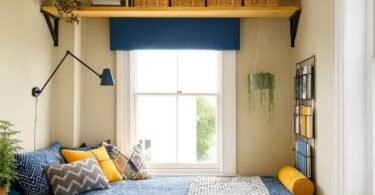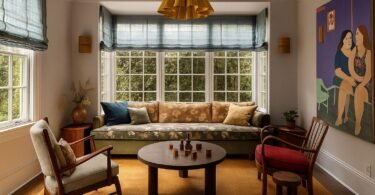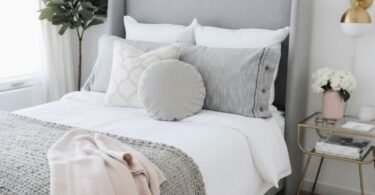Bedrooms should be places we go to feel relaxed, comfortable and calm so that we are in the right frame of mind to sleep. If you are having trouble winding down after a long, busy day, give your chances of a good night’s sleep a boost with some relaxing bedroom design.
Clear Clutter
Let me tell you something that might sound harsh but needs saying: your bedroom probably looks like a tornado hit it. I’m not judging (okay, maybe I am a little), but most of us treat our bedrooms like storage units with beds in them. We toss clothes on chairs, pile books on nightstands, and somehow convince ourselves that stepping over shoes every morning is totally normal. Trust me, I’ve been there. My bedroom once looked like a crime scene where the victim was organization itself.
The truth is, clutter doesn’t just take up physical space. It takes up mental space too. When you walk into a room that’s bursting with random stuff, your brain goes into overdrive trying to process all the visual noise. It’s like trying to meditate in the middle of Times Square. Your nervous system can’t relax when it’s constantly scanning and categorizing all the chaos around you. Studies show that people sleep better in organized spaces, and frankly, you don’t need a PhD to figure out why.
Here’s what I learned the hard way: you can’t organize clutter. You can shuffle it around, buy prettier containers for it, or shove it into closets, but clutter is clutter. The only real solution is to get rid of most of it. Start with the obvious stuff. That pile of clothes on your chair that’s been there so long it’s practically furniture? Deal with it. Those seventeen water bottles on your nightstand? Pick one and banish the rest. The stack of books you swore you’d read someday? Be honest about which ones you’ll actually crack open.

I remember spending an entire weekend decluttering my bedroom, and by Sunday night, I felt like I could breathe again. The space looked twice as big, and I actually wanted to spend time in there. Walking into a clean, organized bedroom feels like exhaling after holding your breath all day. Your shoulders drop, your jaw unclenches, and your mind starts to quiet down. That’s the kind of environment that promotes good sleep.
The minimalist approach isn’t about living like a monk (unless that’s your thing). It’s about being intentional with what you keep around. Every item in your bedroom should either serve a purpose or bring you joy. That ceramic elephant your aunt gave you that you’ve never liked? It can find a new home. Those jeans from college that haven’t fit in five years? Time to let them go. Keep what matters, ditch what doesn’t.
If you’re dealing with storage challenges, get creative with solutions that don’t add visual chaos. Under-bed storage boxes work wonders for seasonal clothes or extra linens. A blanket ladder can hold throw blankets without taking up floor space. Wall-mounted shelves keep books off surfaces while adding architectural interest. The goal is to find homes for things so they’re not constantly cluttering your surfaces and creating that overwhelming feeling.
Light Source
Lighting in bedrooms is trickier than most people realize. We’re not just flipping switches here; we’re basically conducting an orchestra of ambiance that can make or break your ability to wind down at night. I used to think good bedroom lighting meant having enough brightness to find my socks in the morning. Boy, was I wrong. Turns out, the way light moves through your space affects everything from your mood to your sleep quality.
The biggest lighting mistake I see people make is relying on that harsh overhead fixture that came with the house. You know the one I’m talking about. It’s probably brass, definitely dated, and when you flip it on, it feels like someone’s interrogating you about your life choices. Overhead lighting creates shadows in all the wrong places and makes everything look flat and uninviting. It’s the lighting equivalent of wearing socks with sandals.
Natural light control is where the magic happens. Windows are your bedroom’s connection to the outside world, but they need to be managed properly. Heavy curtains can make a room feel like a cave, while no window treatments turn your bedroom into a fishbowl. Interior shutters hit that sweet spot between privacy and light control. They let you adjust the amount of light filtering in throughout the day, creating different moods as needed.
I installed shutters in my bedroom two years ago, and the difference was immediate. In the morning, I can open them partially to let in soft, filtered light that doesn’t assault my barely-awake eyeballs. During afternoon naps (don’t judge, they’re scientifically beneficial), I can close them completely for that perfect cave-like darkness. In the evening, they create this gorgeous dappled light that makes the whole room feel romantic and peaceful.
The key to bedroom lighting is layering. You want multiple light sources at different levels that can work together or independently. Table lamps on nightstands provide task lighting for reading while creating pools of warm light that feel cozy. Floor lamps in corners can wash walls with soft light that makes the room feel larger. String lights or LED strips behind the headboard add a gentle glow that’s perfect for winding down.
Warm light temperatures are your friend in bedrooms. Cool, blue-toned light tells your brain it’s time to be alert and productive. Warm, amber-toned light signals that it’s time to relax and prepare for sleep. This isn’t just aesthetic preference; it’s basic biology. Our circadian rhythms respond to light temperature, so choosing the right bulbs actually helps regulate your sleep cycle.
Dimmer switches are worth their weight in gold. Being able to adjust brightness levels means you can have bright light when you’re getting dressed and dim light when you’re reading before bed. It’s like having multiple lighting scenarios in one fixture. Smart bulbs take this even further, letting you program different lighting scenes and even adjust color temperature throughout the day.
The Color of Calm
Color psychology isn’t just some fancy interior design concept; it’s real science that affects how we feel in spaces. I learned this the hard way when I painted my bedroom bright turquoise because I thought it looked “energizing.” Turns out, energizing is the last thing you want in a bedroom. I spent months wondering why I felt restless and had trouble falling asleep, only to realize my walls were basically shouting at me every night.
Neutral colors work in bedrooms because they don’t compete for your attention. When you walk into a space filled with muted tones, your brain doesn’t have to work hard to process what it’s seeing. Colors like cream, beige, soft grays, and warm whites create a backdrop that feels calm and timeless. They’re like the bedroom equivalent of a gentle hug, making you feel safe and relaxed without overwhelming your senses.
But neutral doesn’t have to mean boring. The secret is in the textures and layers. A room painted in soft cream can feel incredibly rich when you add a chunky knit throw, linen curtains, a jute rug, and some ceramic accessories. Different textures catch and reflect light differently, creating visual interest without relying on bold colors. It’s like creating a monochromatic symphony where every element plays its part in harmony.
I’ve found that earthy tones work particularly well because they connect us to nature, which has an inherently calming effect. Colors like sage green, dusty rose, warm taupe, and soft ochre feel grounding and peaceful. They remind us of natural elements like stone, sand, and dried grass. These colors have been around forever in nature, so our brains are wired to find them soothing.
The texture game is where you can really have fun without sacrificing the calm vibe. Soft, tactile materials invite touch and create that cozy feeling we all crave in bedrooms. Think about how different materials feel against your skin. Smooth cotton sheets, a nubby wool throw, a sheepskin rug underfoot. Each texture adds another layer of comfort and sensory pleasure to the space.
Layering textures also adds visual depth to neutral color schemes. A bed dressed in white linen sheets, a cream wool blanket, and a few textured pillows in varying shades of beige creates interest through contrast rather than color. The eye moves around the space, taking in all the different textures, which keeps things from feeling flat or boring.
Natural fibers tend to feel more luxurious and comfortable than synthetic ones. Cotton, linen, wool, and silk all have unique textures and properties that make them perfect for bedrooms. They breathe better than synthetic materials, which helps with temperature regulation during sleep. They also tend to improve with age, developing a soft, lived-in quality that synthetic materials can’t match.

Spend Less, Sleep More
Creating a peaceful bedroom doesn’t require a trust fund or a complete furniture overhaul. Some of the most relaxing bedrooms I’ve seen were created on shoestring budgets by people who understood that good design is about making smart choices, not expensive ones. The secret is focusing on impact rather than price tags. A few strategic changes can transform your space without emptying your wallet.
White is your budget’s best friend. Paint is the cheapest way to dramatically change a space, and white paint makes everything look more expensive and sophisticated. I once helped a friend transform her bedroom by painting the walls, ceiling, and even the old furniture bright white. The room went from cramped and dated to serene and stylish for less than fifty dollars in supplies. White reflects light, makes spaces look larger, and creates that clean, hotel-like feeling we all love.
Thrift stores and estate sales are goldmines for bedroom furniture that just needs a little love. Old wooden nightstands, dressers, and mirrors often have great bones but outdated finishes. A coat of white paint can turn a dated piece into something that looks like it came from an expensive boutique. I once found a pair of solid wood nightstands at a garage sale for ten dollars each. After sanding and painting them white, they looked like they belonged in a luxury hotel.
The key to successful furniture makeovers is knowing what to look for. Solid wood pieces are always worth rescuing because they’ll last forever once refinished. Avoid anything made of particle board or laminate because paint won’t adhere well and the results usually look cheap. Simple, classic shapes work best because they won’t look dated in a few years. A basic rectangular nightstand painted white will never go out of style.
Wall art doesn’t have to cost a fortune to look sophisticated. Black and white photography, vintage maps, and simple line drawings can be found at thrift stores or even printed at home. The trick is choosing pieces that feel calm and understated rather than busy or colorful. I’ve created beautiful gallery walls using vintage botanical prints that cost less than five dollars each at antique shops.
Mirrors are another budget-friendly way to make bedrooms feel more spacious and luxurious. They reflect light around the room, making everything brighter and more open. A large mirror leaning against the wall creates that casual, expensive look without requiring professional hanging. Vintage mirrors with interesting frames can often be found at estate sales for a fraction of what new ones cost.
Accessories should be simple and purposeful in a budget-conscious relaxing bedroom. A few well-chosen pieces will have more impact than lots of small items scattered around. Glass vases, ceramic bowls, and silver picture frames complement white and neutral color schemes beautifully. These items can often be found secondhand, and their simple shapes ensure they’ll work in any style bedroom.
The beauty of a white and neutral color scheme is that you can change the mood seasonally with just a few accessories. Switching out throw pillows, adding a different colored throw, or changing artwork can refresh the space without starting from scratch. This approach lets you experiment with trends without committing to expensive furniture or paint jobs.
Creating Your Sleep Sanctuary
Your bedroom should be the most peaceful place in your home. It’s where you start and end each day, where you retreat when the world feels overwhelming, and where you recharge for whatever tomorrow brings. Creating a space that truly supports rest and relaxation isn’t about following every design trend or spending massive amounts of money. It’s about understanding what makes you feel calm and building a room around those elements.
The journey to a more restful bedroom starts with honest self-reflection. What makes you feel stressed when you walk into your current space? What would make you excited to go to bed each night? For me, it was realizing that my bedroom had become a catch-all room where I dealt with everything except sleep. Once I committed to making it a true sanctuary, everything else fell into place.

Remember that good design is personal. What relaxes me might energize you, and that’s perfectly fine. The principles we’ve discussed work because they’re based on how humans generally respond to space, light, and color. But the specific way you apply them should reflect your personality and preferences. Maybe you need complete darkness to sleep well, or perhaps you prefer some ambient light. Maybe you love the feeling of heavy blankets, or you prefer light, airy bedding.
The most relaxing bedrooms evolve over time. They’re not created in a weekend shopping spree but developed gradually as you figure out what works for your lifestyle and preferences. Pay attention to how different changes affect your sleep and mood. Keep what works, adjust what doesn’t, and don’t be afraid to try new approaches when your needs change.
Taking care of your sleep environment is really taking care of yourself. When you invest time and energy into creating a peaceful bedroom, you’re investing in better sleep, which affects every aspect of your health and happiness. You’re creating a space that supports your wellbeing rather than detracting from it. That’s worth far more than any design trend or expensive piece of furniture.
Sweet dreams start with thoughtful design choices that put your comfort and peace of mind first. Whether you’re working with a tight budget or have more resources available, the goal remains the same: creating a space where you can truly rest and recharge. Your future, well-rested self will thank you for the effort.







Leave a Comment